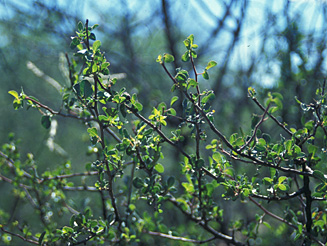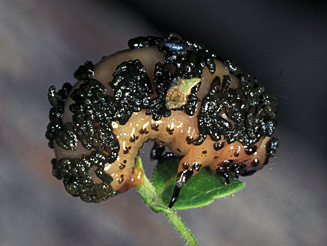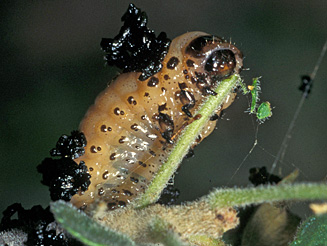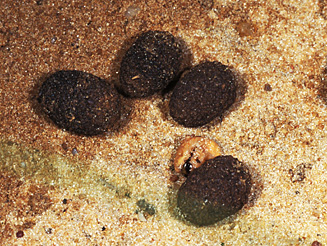|
Diamphidia (arrow poison beetles)
Life > Eukaryotes > Opisthokonta > Metazoa (animals) > Bilateria > Ecdysozoa > Panarthropoda > Tritocerebra > Arthopoda > Mandibulata > Atelocerata > Panhexapoda > Hexapoda
> Insecta
(insects) > Dicondyla > Pterygota > Metapterygota > Neoptera > Eumetabola >
Holometabola > Coleoptera
(beetles)
> Polyphaga > Superfamily: Chrysomeloidea
> Family: Chrysomelidae > Subfamily: Alticinae
Life cycle of Diamphidia nigroornata
|
 |
 |
|
Adult. Feed on the host plant by day and if disturbed they quickly drop to the
ground or fly off.
|
Eggs are elongate, ovate with an orange tint and are laid on the branches of Commiphora
plants (right) in batches of up to 15 eggs each, closely attached to
one another. After laying a batch of eggs, the female covers it with
greenish excrement, using her back legs to build up the deposit. On
drying, this excrement becomes dark-brown in colour and becomes well
camouflaged against the branch to which it is attached. |
|
 |
 |
|
Larvae pass through three instars (i.e. stages: each instar is separated by
moulting of the cuticle). They feed on the leaves of the host plant. |
Larvae are parasitised by a species of
Carabidae beetle
called Lebistina holubi. The Lebistina larvae by attaching
themselves to full-grown Diamphidia vittatipennis larvae, get into their
cocoons where they feed on blood and soft parts of the Diamphidia larvae,
eventually killing them. |
|
 |
|
|
Upon completion of their development on the host plant, the larvae
burrow down 0.5 - 1 m into the sandy soil in close proximity
to the host plant bush. They then makes a cocoon round themselves from
sand, and secretions from the anal region. The larvae remain curled up in
the cocoon for up to several years before finally moulting into pupae.
This variable period of arrested development explains why San hunters are
able to find cocoons throughout the year, for using as poison on their
arrows.
[All photographs by HG Robertson,
Iziko ©. Photographed in 'Bushmanland',
NE Namibia, in February 1996] |
|
Read about how San
hunters use the cocoons as a source of poison for their arrows.
References
Text and photos by Hamish Robertson
|
